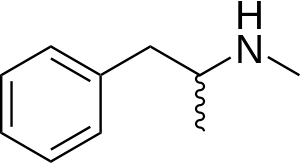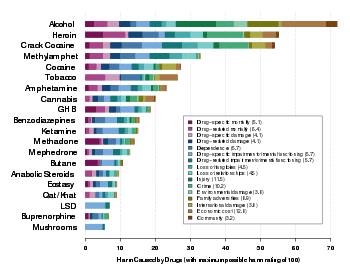Amphetamine dependence
Amphetamine dependence refers to a state of psychological dependence on a drug in the amphetamine class. In individuals with substance use disorder (problematic use or abuse with dependence), psychotherapy is currently the best treatment option as no pharmacological treatment has been approved.[1] Tolerance is expected to develop with regular substituted amphetamine use.[2] When substituted amphetamines are abused, drug tolerance develops rapidly.[1] Psychostimulants – including amphetamine and methamphetamine – do not cause physical dependence.[3]
| Amphetamine dependence | |
|---|---|
 | |
| The structural formula of methamphetamine | |
| Specialty | Toxicology, psychiatry |
The acute effect of amphetamine use manifests itself in euphoria, intensification of the train of thought, speech and motoricity and an increase in initiative and urge to move. In case of chronic abuse, vegetative disorders soon occur such as bouts of sweating, trouble sleeping, tremor, ataxia and diarrhea; the degradation of the personality takes place relatively slowly.[4]
Severe withdrawal associated with dependence from recreational substituted amphetamine use can be difficult for a user to cope with.[5][6][7] Long-term use of certain substituted amphetamines, particularly methamphetamine, can reduce dopamine activity in the brain.[8][9] Psychostimulants that increase dopamine and mimic the effects of substituted amphetamines, but with lower abuse liability, could theoretically be used as replacement therapy in amphetamine dependence.[1] However, the few studies that used amphetamine, bupropion, methylphenidate and modafinil as a replacement therapy did not result in less methamphetamine use or craving.[1]
In 2013, overdose on amphetamine, methamphetamine, and other compounds implicated in an "amphetamine use disorder" resulted in an estimated 3,788 deaths worldwide (3,425–4,145 deaths, 95% confidence).[10]
References
- Pérez-Mañá, C; Castells X; Torrens M; Capellà D; Farre M. (September 2013). "Efficacy of psychostimulant drugs for amphetamine abuse or dependence". Cochrane Database of Systematic Reviews. 9 (9): CD009695. doi:10.1002/14651858.CD009695.pub2. PMID 23996457. Retrieved 8 September 2013.
- O'Connor, Patrick. "Amphetamines: Drug Use and Abuse". Merck Manual Home Health Handbook. Merck. Retrieved 26 September 2013.
- Malenka RC, Nestler EJ, Hyman SE, Holtzman DM (2015). "Chapter 16: Reinforcement and Addictive Disorders". Molecular Neuropharmacology: A Foundation for Clinical Neuroscience (3rd ed.). New York: McGraw-Hill Medical. ISBN 9780071827706.
Pharmacologic treatment for psychostimulant addiction is generally unsatisfactory. As previously discussed, cessation of cocaine use and the use of other psychostimulants in dependent individuals does not produce a physical withdrawal syndrome but may produce dysphoria, anhedonia, and an intense desire to reinitiate drug use.
- J. Saarma "Kliiniline psühhiaatria". Tallinn, 1980, p. 139
- Chronic Amphetamine Use and Abuse Archived April 3, 2010, at the Wayback Machine
- Sax KW, Strakowski SM (2001). "Behavioral sensitization in humans". J Addict Dis. 20 (3): 55–65. doi:10.1300/J069v20n03_06. PMID 11681593.
- I. Boileau; A. Dagher; M. Leyton; R. N. Gunn; G. B. Baker; M. Diksic; C. Benkelfat (2006). "Modeling Sensitization to Stimulants in Humans: An [11C]Raclopride/Positron Emission Tomography Study in Healthy Men". Arch Gen Psychiatry. 63 (12): 1386–1395. doi:10.1001/archpsyc.63.12.1386. PMID 17146013.
- Malenka RC, Nestler EJ, Hyman SE (2009). "15". In Sydor A, Brown RY (eds.). Molecular Neuropharmacology: A Foundation for Clinical Neuroscience (2nd ed.). New York: McGraw-Hill Medical. p. 370. ISBN 9780071481274.
Unlike cocaine and amphetamine, methamphetamine is directly toxic to midbrain dopamine neurons.
- Krasnova IN, Cadet JL (May 2009). "Methamphetamine toxicity and messengers of death". Brain Res Rev. 60 (2): 379–407. doi:10.1016/j.brainresrev.2009.03.002. PMC 2731235. PMID 19328213.
Neuroimaging studies have revealed that METH can indeed cause neurodegenerative changes in the brains of human addicts (Aron and Paulus, 2007; Chang et al., 2007). These abnormalities include persistent decreases in the levels of dopamine transporters (DAT) in the orbitofrontal cortex, dorsolateral prefrontal cortex, and the caudate-putamen (McCann et al., 1998, 2008; Sekine et al., 2003; Volkow et al., 2001a, 2001c). The density of serotonin transporters (5-HTT) is also decreased in the midbrain, caudate, putamen, hypothalamus, thalamus, the orbitofrontal, temporal, and cingulate cortices of METH-dependent individuals (Sekine et al., 2006).
- Collaborators (2015). "Global, regional, and national age-sex specific all-cause and cause-specific mortality for 240 causes of death, 1990-2013: a systematic analysis for the Global Burden of Disease Study 2013" (PDF). Lancet. 385 (9963): 117–171. doi:10.1016/S0140-6736(14)61682-2. PMC 4340604. PMID 25530442. Retrieved 3 March 2015.
Amphetamine use disorders ... 3,788 (3,425–4,145)
